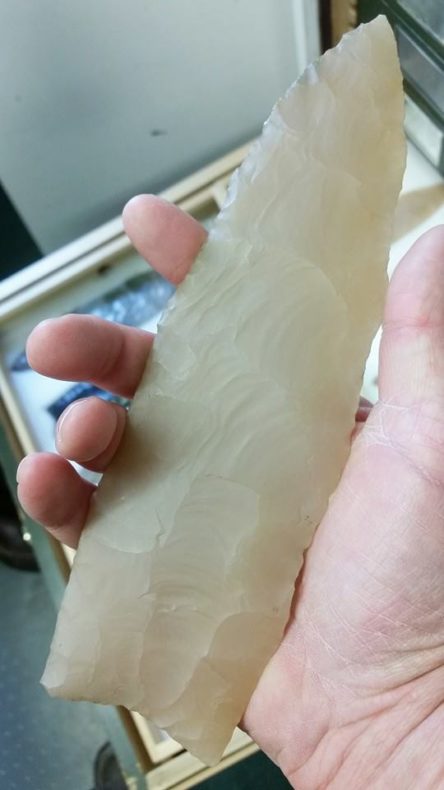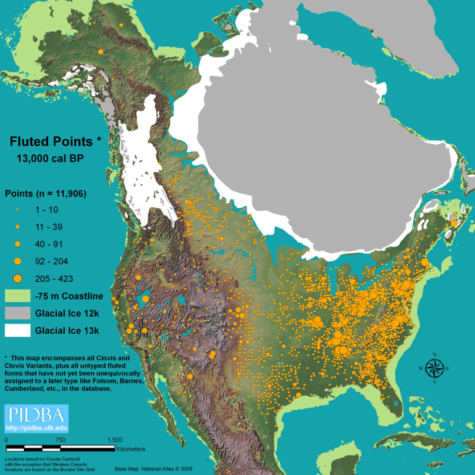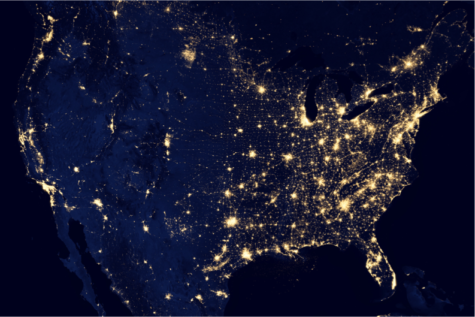 We were great in the Ice Age. Big weapons, big animals, big land.
We were great in the Ice Age. Big weapons, big animals, big land.
While parts of the world were crawling with hominids for a million years or more, this side of the planet was off limits. Getting here was never easy, not in the late Pleistocene, not now. The Americas are bookended by the world’s two largest oceans and occasionally connected by an Arctic land bridge. For most of human history, this country was vast, open, and unexplored, and anyone who arrived had to either really want it, or they were terribly lost.
As a new assault rises against refugees and a freshly minted president tries to keep the door open for some and close it for others, it is time to consider the longer history of this place.
Ours has been a country for refugees and far-flung travelers since the beginning. In the late Pleistocene, the only way to show up on foot was the middle of a subcontinent exposed between Siberia and Alaska when continental ice was up and sea levels were down. This access point was, and still is, at the far end of the world. To survive far northern conditions within shooting distance of the land bridge, people had to invent portable architecture and tailored clothing, represented by the advent of stone microblades for precisely cutting skins, and eyed sewing needles fashioned out of mammoth ivory found in both Siberia and Alaska.
Last month a promisingly early date of 24,000 years ago came from clearly butchered Pleistocene horse bones excavated from Bluefish Caves just inside Yukon Territory from the Alaska border. This probably wasn’t the first human sign across the Bering land bridge. Bluefish Caves have also produced human-smashed mammoth bones going back 40,000 years. Richard Morlan, a late archeologist who worked at Bluefish Caves in the 70s and put together the Canadian Archaeological Radio Carbon Database, found these shattered bones and concluded they’d been left by early people lifting rocks overhead and slamming them down, creating a specific kind of break you don’t see in trampling or general erosion. Morlan wrote, “a new agency or process enters into the taphonomic histories of large vertebrates in the Old Crow Basin around 40,000 BP.”
On the other side of the continent, Chesapeake Bay outside of Washington D.C. has been producing curious artifacts between 17,000 and 20,000 years old. One leaf-shaped stone blade dredged up with a jumble of mastodon bones dates to 23,000 years ago. Researchers at the Smithsonian believe these artifacts are based on a Solutrean design, meaning they could belong to sea ice hunters who would have come across the Atlantic from northern Spain.
White supremacists have run with this Solutrean hypothesis, claiming Europeans were first, giving American racism a history it does not have. These would have been Paleolithic Europeans not historic Europeans. They were not White, nor were they planting a flag by arriving here, probably lost, following birds and seals, wondering how to get home. Their genes appear to be lost to Native America, suggesting that Solutreans may have arrived, but they did not ultimately survive, one of many failed arrivals in this country’s history.
Meanwhile, boat travelers were coming down the West Coast between 17,000 and 14,000 years ago, landing at a well-established coastal sites, namely Monte Verde in southern Chile where they ate fish, seaweed, and mastodon.
Numbers keep rising. By 13,000 years ago, Clovis megafauna hunters moved into the North American interior, setting up routes of traffic by carrying toolstone from place to place. Comparing the distribution of fluted points found in North America, which is evidence of Clovis influence, to an image of this continent seen by satellite at night, you see that the two look the same. The East is brightly marked, sites clustered and overlapped from the Eastern Seaboard to the Great Plains, scattering as the Rockies approach. In the West, lights break up into river corridors and parks, following routes through mountains and spilling into basins. Most of the West becomes archaeologically dark, same as today.

 While the Ice Age seems forever ago, some influences have changed little. Conflict shows up early. Kennewick Man, 9,000 years old, has a stone projectile lodged in his hip, the bone healed and grown back over the point, sealing it inside his body.
While the Ice Age seems forever ago, some influences have changed little. Conflict shows up early. Kennewick Man, 9,000 years old, has a stone projectile lodged in his hip, the bone healed and grown back over the point, sealing it inside his body.
By the time of Christopher Columbus’ arrival at the tail end of American history, the Americas already had a thousand distinct languages.
I reflect on this as protesters storm airports in defense of a very American tradition. It may not be easy getting here, but this is not a walled off country. This is not a White country, not a Christian one, not an English-speaking one. It is a land of arrivals from many directions, and has been from the start. No one can show up and close the door.
Images: Clovis point/author, map/Paleoindian Database of the Americas, night scene/NASA.
I’m sure I read this before. Maybe somewhere else?
I’m living in the Ice Age, so this sentiment may have leaked out at another time on LWON. But these words appeared here first, assembled just now.
Are you referring to the continent formerly known as (a part of) Pangaea? It seems that so many of the paradoxes we bind ourselves in originate in limiting our impressions to arbitrary timescales that compliment our anthropocentric and tribal ideas of “the world.” Really, what are the qualifications for greatness in the Higgs field? 🙂 How about we just strive to make the most out of the blink of consciousness we are each given?
Thanks Craig, good piece…I wrote about that chopper in 2012 and sent a photographer (a general assignment person at WaPo) to the Smithsonian to get a photo of it. She came back and said it was a boring shoot without much to look at. I almost shouted, “IT’S A 20,000-YEAR-OLD-TOOL MADE BY YOUR ANCESTORS” but instead just pitied her for not understanding the deep joy of discovery.
The hardest thing to get over, always, is wanting things to always stay the same. I just keep reminding myself how much trouble we’d have on our hands if they did.
Amen, Brother.
Image credit of the Clovis point cast should probably acknowledge the Paleoindian Collection, National Museum of Natural History, Smithsonian Institution. It appears to be one of the intentionally oversized fluted bifaces excavated at the Ritchie Roberts site near Wenatchee, Washington.
Not sure who added “your comment is awaiting moderation” or why.
“Comment awaiting moderation” is standard message from LWON’s web hosting service. It translates to: LWON doesn’t publish all commemts, only those that aren’t spam and that seem sincere, thoughtful, and civil. As yours does. Sometimes it takes a while for LWON to get around to doing this.
Thanks Pegi, it was a shot I took while visiting Dennis, remarkable point.
Appreciated as one of the Original Native Americans– if you ever get a chance listen to archives of Buffalo Talk–Wolf Spirit Radio and you may glean some oral history.